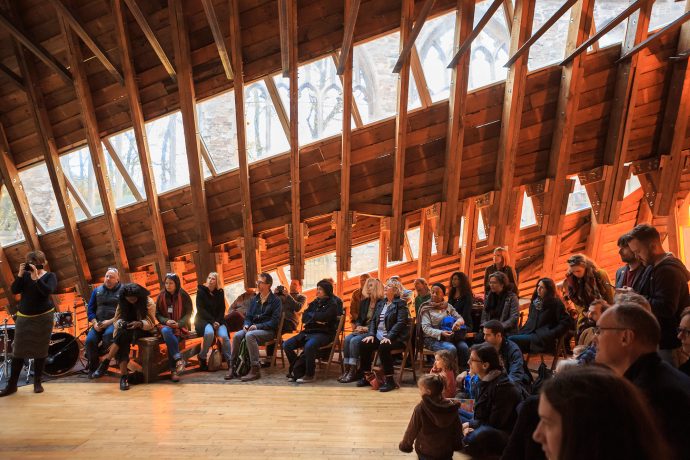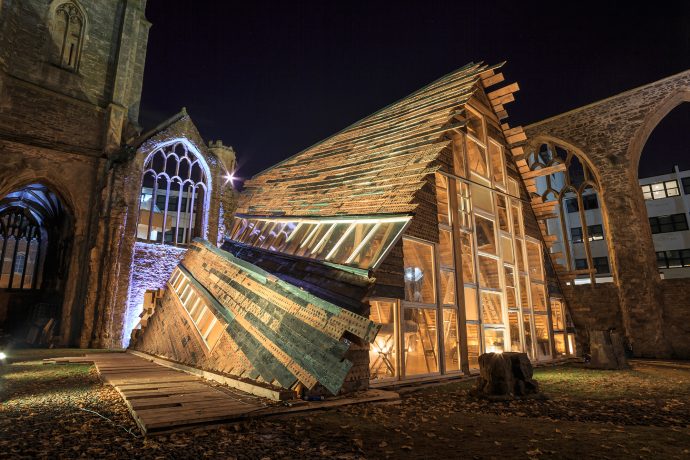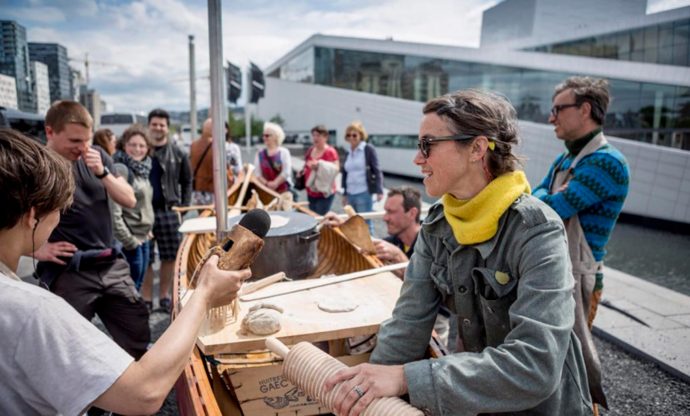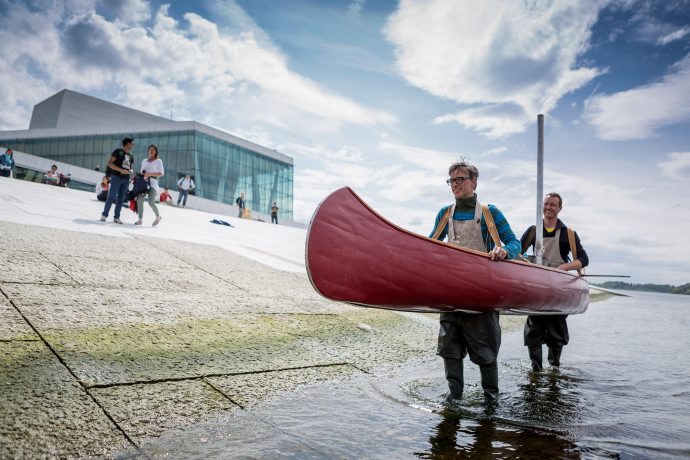Claire Doherty’s critical charisma

Migratory landmasses and buried treasure; a sanctuary in a bombed-out church; a nomadic bakery escorted by canoe; a forest to be tended to for a century before metamorphosing into an anthology of words. All are ideas that have come alive under the helm of Claire Doherty and the public art organisation she directs, Situations. Headquartered in Bristol, UK, but with a tentacular presence all over Europe, Situations places artists at the forefront of change – be it environmental, social, political or economic. The work they realise disrupts popular assumptions about the permanence and grandiosity of public art, deftly bridging 100-year projects with fleeting moments of intimacy.
Claire prefers the title ‘producer’ rather than ‘curator’ – she believes it speaks more holistically to the process of selecting, shaping and managing an idea that she and her team engage in with an artist. Projects they have nurtured into existence include Alex Hartley’s Nowhereisland, an island that journeyed from an archipelago in the High Arctic to the southwest coast of England during the 2012 Cultural Olympiad. In making this colossal pilgrimage through international waters, it thereby became a new nation – with citizenship open to everyone. 2013’s Flatbread Society saw artist Amy Franceschini and the Futurefarmers collective construct a temporary bake-oven on the shores of Bjørvika, Oslo, exploring different modes of flatbread production and baking stories from the community, paving the way for the permanent public bakehouse and urban grain fields now in the pipeline.

In Folkestone Digs Michael Sailstorfer buried a bounty of 24-carat gold under the sand of Outer Harbour beach in Folkestone, Kent. (Open to the public to dig for (and keep!), Sailstorfer’s collective treasure hunt was part of the Folkestone Triennial in 2014.) Meanwhile, The Future Library, a project conceived of by artist Katie Paterson, has seen a forest planted in Norway that, come 2114, will be felled in order to publish 100 previously unseen texts.
Taking place at the end of last year, Sanctum is the first major UK project by Chicago-based artist Theaster Gates, which incorporated a structure built by, for and from Bristol in the bombed remains of the 14th-century Temple Church, accompanied by a 552-hour continuous programme of sound. I chatted with Claire over Skype and email, either side of the frenzy and bustle surrounding Situations’ recent project with Gates.


Rachel Elliot-Jones: Sanctum situates Theaster Gates’ work in your local context. What prompted this project on home turf?
Claire Doherty: We’ve been thinking for some time at Situations that we wanted to do a project of scale in our home city. I’d been following Theaster’s practice for some years and was intrigued by the way in which transformation occurred in his work and how that might change outside Chicago. And of course, as often happens, we were invited to submit an idea for the cultural programme of Bristol 2015 European Green Capital. Theaster was my first and only choice as an artist who would bring a fresh perspective to the question of sustainability.

REJ: That’s something that has resonated with me in all Situations projects – there is more often than not an underlying environmental message, but it’s rarely communicated in a direct or overt manner.
CD: Yes I think that’s true. The nature of each project is unique but all are underpinned by the organisation’s core values: a belief in the capacity for the arts to bring about change and for artists as the catalysts of that change. Theaster speaks about his works as symbolic gestures that may have direct real-life effects. The symbolic is powerful because it brings about a cultural shift, which makes something else happen. Situations is born out of a history of socially engaged practice, but our programme is characterised by highly visual or experiential works – the charismatic objects and architecture that draw in participants and audiences.
If you look, for example, at the Futurefarmers’ boat oven, conceived as a talking point for the artists’ Flatbread Society project in Oslo, the artists used this extraordinary nomadic object as a means of introduction into the communities of East Oslo. Amy Franceschini speaks about those extraordinary objects in a film interview as part of the Public Art Now series online.
In the case of Theaster’s Sanctum, the temporary structure is not only made in Bristol but also from materials sourced solely in the city. Its curious and comforting architectural form, an inner sanctum within the ruin of a church, was an important factor in the success of the project to draw in audiences who might never have experienced contemporary art before. This integration of the audience in the work as it unfolds is a common characteristic of many of our projects. Without the involvement of the performers and the attendance of the audience day and night over 552 hours, Sanctum would have just been an architectural installation.
When the artist Michael Sailstorfer buried gold under the sand of a beach in Folkestone, the work only became activated through the ‘gold rush’ that ensued. That activation or reaction was in effect the work itself.
In Alex Hartley’s Nowhereisland, we saw a range of different kinds of responses. For some, Nowhereisland existed as a remote, alien island offshore; for others, the project became a means to become a citizen of a new nation online and to contribute ideas about how that nation might be run.
We try to avoid the idea that a work is ‘about’ a set of issues or driving home a single message. The best projects are those that allow for multiple perspectives to emerge, allowing the audience to speak back to the work and for that response to be folded in the work itself.


REJ: Is a multidisciplinary approach also critical to your work?
CD: I certainly feel that our visual arts root is an important part of our critical compass, but as artists have led us to embrace other forms of the arts – from music to performance, immersive theatre to fiction – so our own frame of cultural reference has changed over the years. We are moving towards a more collaborative process of making.
Someone like Theaster Gates, for example, is effectively an artistic director who works with a range of talented collaborators – he kick-starts a set of conversations to enable new ideas to take flight.
We are in a moment of change for the organisation, in which we have been expanding the range of different kinds of producers we work with to encompass those with theatrical and performance experience. Our projects require very different approaches: from a lightness of touch (where an artist has a strong and clear idea of what they’d like to do), to a more collaborative, creative and exploratory way of working. Throughout, though, Situations is committed to testing out new forms of engagement. So, enabling a depth of experience before, during and after a project (via digital and online possibilities) has become an important part of how we work.
REJ: I think there’s also a sense of humour and imagination that sets the tone for Situations programmes. My favourite proposition in the Nowhereisland constitution is ‘All citizens will be given a towel and should always know where their towel is.’
CD: [Laughing] Oh that is amazing – I’d forgotten about that, but it’s so good! There was a lovely tongue-in-cheek quality in the way that people reacted to [Nowhereisland]. And that came out in Sanctum too. One of my favourite moments was a Sunday afternoon jungle set with an MC dressed in Superman pants imploring toddlers and pensioners to rave!
Perhaps this is something that connects to Assemble – our interest in trying to find a way to live together. Public projects spark the imagination but they also give opportunities for humour or a surreal take on how we view the world. That’s certainly one of the reasons why it’s so interesting for me to continue to work in the public realm – because every single project starts from scratch and you’re working directly in spaces of people’s lives.


REJ: Situations is such a nimble organisation and, by virtue of this, seems to have the power to influence the not-so-nimble to commit to long-term ideas. I’m thinking particularly of Katie Paterson’s Future Library in Oslo, which requires a 100-year commitment from the city. How on earth did you get that off the ground?
CD: [Laughs] Not easily! It took a great many early meetings to lay the groundwork for artists who work in this way from 2010-12 and then of course the work of a great many people on the ground in Oslo.
It’s true that we are nimble and there are projects such as Nowhereisland and Sanctum that we initiate from scratch, often relatively quickly over say two years. But there’s another side of our work – at least half of our work – that involves working with local authorities over many years to initiate projects as part of public art programmes for the city.
In the case of Oslo, we were lucky enough to be supported by a project director on the ground. We worked together for two-and-a-half years before we even approached an artist. When Katie Paterson proposed Future Library, we took it through a number of different iterations before we found the right structure, which also involved discussing previous projects from which we could learn – such as Jem Finer’s Longplayer, a thousand-year project. Artangel, who were the commissioners of that project, were incredibly helpful in advising us on how to set up the Future Library Trust, which would manage the project over the 100-year period.
The crucial player in all of this was the Deichmanske Library – the city library, which was being built on the harbour. It turned out the outgoing director of the library had always wanted to build a library of unpublished texts – serendipity! You know how these things sometimes just perfectly connect. We worked hard to secure Margaret Atwood as the first writer with the help of the late Ion Trewin, the Literary Director of the Booker Prize. And from there it just developed.


REJ: Kindred forces aligned…
CD: For many of these projects it’s about working with people who are willing to take a risk; when that happens and you work together to make something happen that no one believed could – that’s the magic.
REJ: It’s difficult to imagine the same thing happening in Australia. We’re subject to a constantly shifting funding landscape tied to changes in political leadership, which I know has similarities in the UK. How have you negotiated this context in your own work?
CD: The hardest thing is producing good projects in spite of the challenges, in spite of the changes. There have been projects that we’ve produced that didn’t work out as we hoped because the context changed or the funding was withdrawn and whilst they were good enough – they were not exceptional. That’s the real challenge.
REJ: You don’t want to compromise.
CD: No! And that is really hard, and sometimes it’s better not to do it at all rather than compromise. Through our program Public Art Now, we’re attempting to effect change in public policy for public art and how local authorities value artists. Theaster recounts in his interview with us that the problem with public art policy is that artistic process is not valued for its own sake. That gets to the essential problem that occurs when artists are invited to create work – it’s all about outcome. Theaster made an interesting suggestion, that you phase your expectations, allowing the commissioner or local authority to go on a journey with you, rather than be governed by the outcome.

REJ: I’ve found that in times of poor leadership, there’s a groundswell of political activism among my peers. We’re more riled up for change – a silver lining to the situation.
CD: Yes, I think you are absolutely right. It certainly feels in the UK there’s a sense of urgency. The inner sense that we’ve got to make change quicker, and that there’s a fundamental paradigm shift in how people are consuming and engaging with culture. Situations has a fair degree of flex in that we’re not set in stone as to how we talk and engage with our audiences [unlike larger institutions]. That means of course that we are vulnerable… but at the same time we’re much more able to change according to the funding landscape and the changes in culture. In terms of deeper societal changes, there are a number of challenges to do with event culture. When we make an event – like Theaster Gates’ Sanctum – how do you take care of that not just becoming another festival, another thing to be consumed? What about when there is that criticality in it? You’ve got to preserve that somehow and that means producing a project on the basis of a set of principles and values. That’s what we keep coming back to.
Thanks to Claire for taking the time to speak to us about Situations. Claire Doherty will be speaking at the booked-out discussion ‘Art at Large’ for The Wheeler Centre on June 14, while she’s in Australia to work with artists on projects around the Queen Victoria Market as part of the City of Melbourne’s 2016 Public Art Melbourne Biennale Lab.